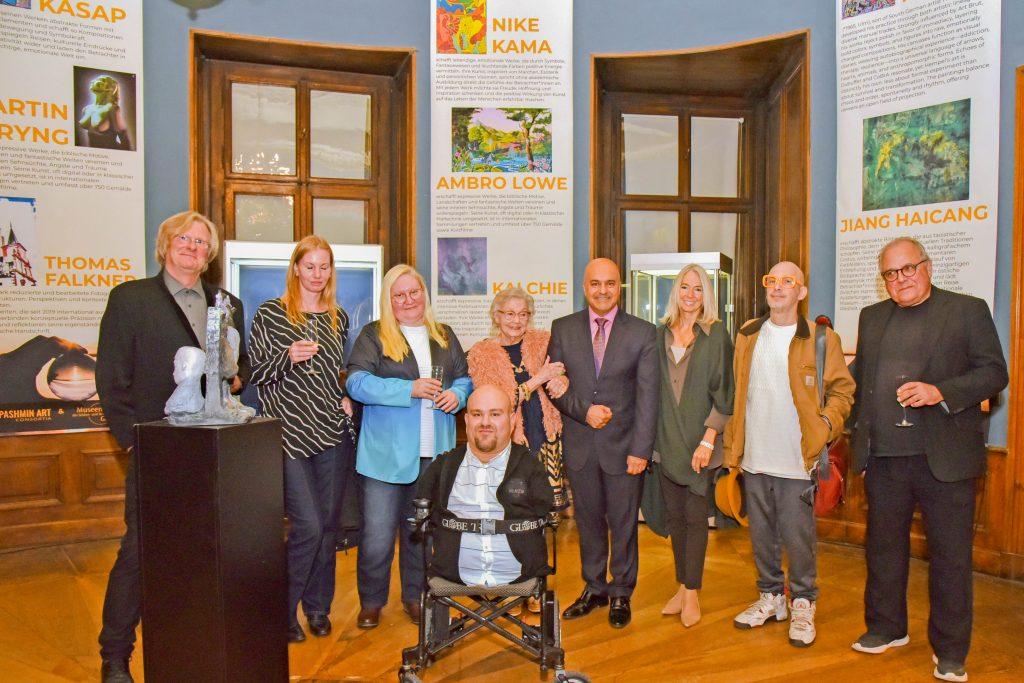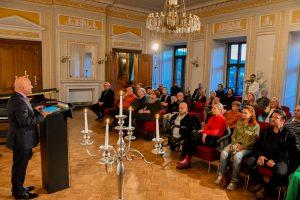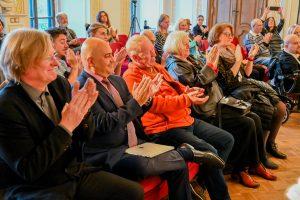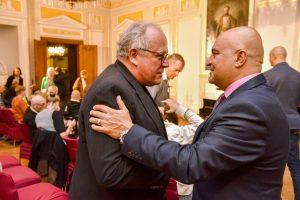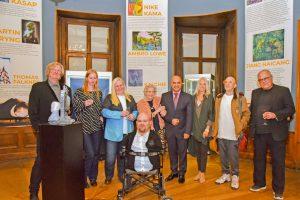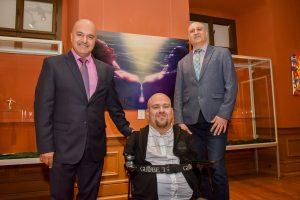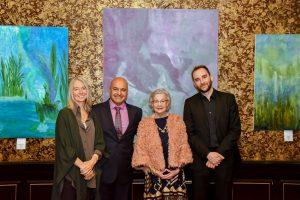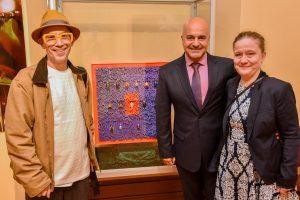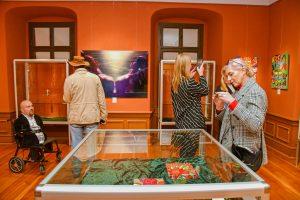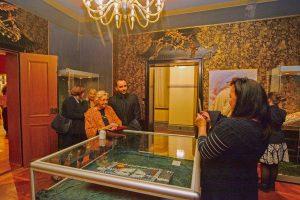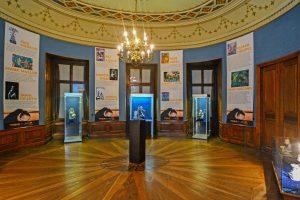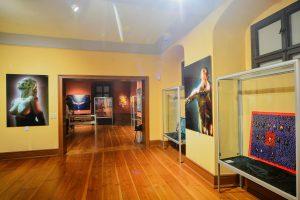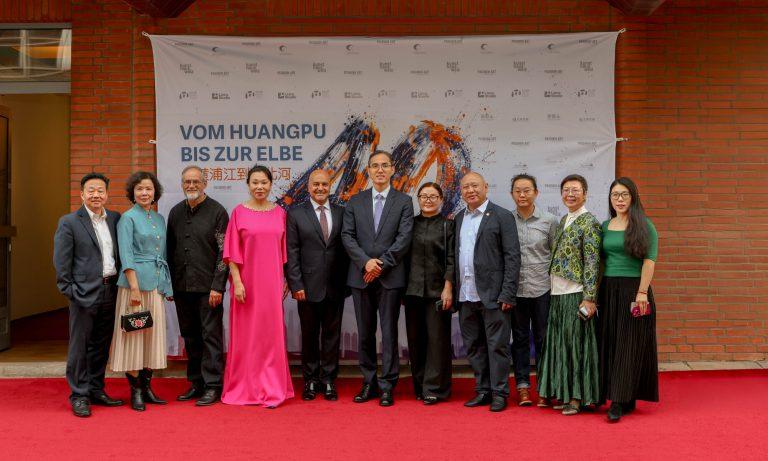Greiz Castle and Residence Museums (Museen der Schloss- und Residenzstadt Greiz) (Thuringia, Germany)
Duration: 3 October – 22 November 2025
Curatorial Team
Rainer Koch (Director, Museums Greiz)
Nour Nouri (Director, Pashmin Art Consortia)
Dr. Davood Khazaie (International Curator)
A Living Dialogue Between Past and Present
Now in its final weeks, Reflections and Resonances continues to captivate visitors in the historic halls of the Greiz castle-museums, where centuries-old walls echo with contemporary voices. The exhibition, inaugurated on 3 October 2025, brings together twelve artists from Europe and Asia, each exploring the interplay of reflection, transformation, and human perception through their own visual language.
At the opening, Rainer Koch and Nour Nouri spoke of art as a bridge between epochs — a living resonance between memory and innovation. Their remarks were interwoven with a lyrical piano performance by Álvaro Baltanàs Meliveo, transforming the vernissage into a multisensory dialogue between space, sound, and image. Artists Kalchie, Mark Müller, Thomas Falkner, Martin Ryng, and Nike Kama attended in person, adding a personal dimension to the evening.
I. Structure, Geometry, and Visual Rhythm
Several artists in Reflections and Resonances approach abstraction as a language of order and movement.
Ali Kasap’s dynamic paintings — including Francois — merge geometry and figuration in bold tonal contrasts, where color acts as both architecture and emotion.
Mark Müller extends this inquiry into wooden sculptural form: his wall structures (like Two People) and his spirals translate geometric clarity and human connection into meditative order, exploring light, shadow, and balance.
Thomas Falkner offers a photographic-painting counterpart with his urban scenery (such as Transcendence and Traffic), reducing the city to elemental rhythm and proportion.
Together, these artists demonstrate how structure itself can vibrate with human resonance — precision as a pathway to emotion.
II. Nature, Abstraction, and Inner States
In a quieter but equally powerful register, another group transforms abstraction into introspection.
Elmar Hempel’s mixed-media works, such as Streit um den Fisch, combine Art Brut expressiveness with emotional rawness, turning paint and texture into testimony.
Kalchie’s art like Nacht radiates spiritual stillness: color as energy, brushstroke as devotion.
Ambro Louwe’s lush landscapes, notably Jungle, fuse poetic narrative and natural rhythm into chromatic abundance.
Martin Ryng continues this reflection through mythic, dreamlike compositions such as Jungfrau, bridging fantasy, faith, and inner transformation.
Here, the natural world becomes psychological terrain — the landscape of the mind rendered visible through gesture, pigment, and rhythm.
III. Human Presence and Emotional Resonance
The human figure re-emerges throughout the exhibition, not as depiction but as emotional atmosphere.
Janih Ch. Lüthi’s photographic series — including Whispering Petals — stages intimate encounters with light, capturing fragility, grace, and silence.
Nike Kama, in contrast, celebrates brightness and naïveté: in Welt, vivid colors and mythic creatures convey the conviction that art can heal through joy.
Kiko Morales infuses his detailed drawings, such as A Lonely Road, with poetic symbolism, merging animal, human, and celestial forms in a visual dialogue between fate and transcendence.
Each of these artists redefines portraiture as empathy — the face, the body, or the symbol becoming vessels of reflection and emotional exchange.
IV. Cultural Continuities and Philosophical Vision
The exhibition culminates in the works of two masters whose practices connect contemporary art to the philosophical and spiritual depth of Asian aesthetics.
Jiang Haicang, known as the “Formless Wave Man,” merges calligraphy, philosophy, and abstraction in his Yi Xiang style, grounded in the Book of Changes. His works transform brush and ink into metaphysical dialogue — a rhythm between the visible and the cosmic.
Wang Shaojun, professor at the Central Academy of Fine Arts in Beijing (CAFA), anchors the exhibition in sculptural monumentality. His Psychic unites human form and spiritual reflection, continuing his lifelong exploration of how art embodies history, belief, and continuity.
Together they form a meditative coda — an East–West dialogue that situates the exhibition’s theme on a universal plane.
Reflection, Memory, and Continuity
Within the centuries-old architecture of Greiz castle-museums, these twelve artistic voices form a conversation across cultures, materials, and generations. Reflections and Resonances invites viewers to perceive art not as representation but as echo — a continuum where structure mirrors feeling, and the past resonates within the present.
As the exhibition continues until 22 November 2025, it reaffirms the mission shared by Pashmin Art Consortia and Greiz Castle-Museums: to reveal how contemporary art, in all its diversity, can transform historical space into a site of living reflection.
Exhibition Details
Title: Reflections and Resonances – Contemporary Art in Historic Greiz
Venue: Greiz Castle and Residence Museums (Museen der Schloss- und Residenzstadt Greiz), Thuringia, Germany
Duration: 3 October – 22 November 2025
Curators: Rainer Koch, Nour Nouri, Dr. Davood Khazaie
Organizers: Pashmin Art Consortia & Museums Greiz
Musical Guest at Opening: Álvaro Baltanàs Meliveo
Links:
